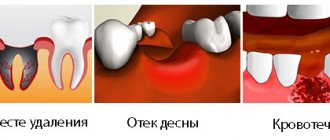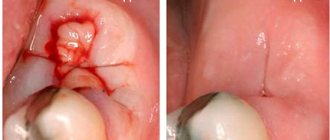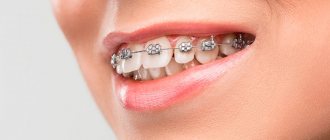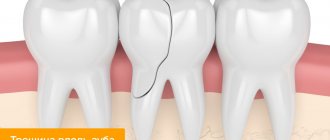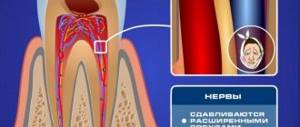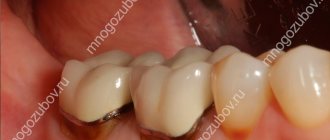When the wall of a tooth breaks off, there is no need to remove it
The attending physician tells: Rafikova Dinara Dzhafarovna
A patient was referred to me on a recommendation from a colleague. The patient is a very anxious young woman, 32 years old. Conducts serious work in the diplomatic field. She quickly revealed the essence of her problem - while eating, the wall of her tooth chipped. There was no pain whatsoever.
Choosing a doctor is a success in most cases of treatment
The girl was so disheartened by what had happened that she immediately contacted her dentist. Having arrived at his appointment, he threw up his hands and sentenced this tooth to be removed, explaining this decision by the fact that the wall of the tooth had chipped deep under the gum. But the patient is categorically against removal and decided to listen to the opinions of other doctors. So, I have her, and in my thoughts I have already come to terms with the fact that this tooth will most likely have to be removed.
Examination revealed a chipped tooth wall
I started the inspection. The tooth, or rather what is left of it, is the buccal and chewing walls. There is no palatal wall and it is not really deep under the gum.
The photo shows that the palatal wall of the tooth is chipped.
The chip line went deep under the gum
Previously, the tooth was treated in another clinic: the nerve was removed, the canals were filled (endodontic treatment), and the tooth was restored with filling material. But they didn’t take a really important step - making a crown. In the case of teeth from which the nerve is extracted, this is precisely the step that determines the viability of this tooth. Over time, the walls of a tooth that has undergone endodontic treatment become fragile. And at some point, excessive chewing pressure leads to chipping.
But at what level the chipping will occur - above the gum level or below the gum level - is absolutely unpredictable. This is exactly the scenario that developed in my patient - the wall of the tooth broke off. But no luck - the chip went deep below the gum level. The gum itself in the area of the chip looks good for now, but over time it will collapse into the area of the missing wall.
When examining X-ray photographs, I saw that the root canals were filled satisfactorily, no changes were detected in the area of the apex of the tooth. The root of the tooth itself was in good condition.
And a dilemma loomed: should I really remove the tooth and place an implant?
Or try to do specific manipulations with it that will help save the tooth.
The patient listened with wide eyes to the option of a rescue operation.
The rescue plan seemed very difficult! Namely: pull the tooth out of the bone, and then, under the control of working with the boundaries of the gingival area of the tooth, prepare the tooth for a crown, make a temporary crown and use it to form the correct contour of the gums, and only then make a permanent crown.
“Extreme tooth traction method” was the name of the rescue operation. It implies that the tooth is constantly exposed to traction forces, due to which the tooth moves from the bone and, as a result, it is technically possible to treat the subgingival level of the fracture.
Content
- Feelings when a tooth breaks off
- Types of tooth chips
- Methods of tooth restoration
- Chip of baby tooth
- Choosing a method for restoring teeth
- Application of a crown
- Prevention of chips
Tooth enamel is very strong, but this strength is not unlimited. The most common damage is chipped teeth. In small volumes they are not painful, and people do not pay attention to the affected aesthetics. Dentists recommend treating these injuries with utmost care.
Reasons for chipping:
- Fall or blow;
- Biting a hard product;
- Hormone imbalance;
- Caries;
- Poor immunity;
- Malocclusion.
Provoking factors are:
- Incorrect load distribution;
- Calcium deficiency;
- Hereditary factors.
The greatest risk of chipping exists for pulpless teeth with fillings, because without nutrition they become fragile.
Now I will clearly describe this technique from the photo.
Retention points are fixed to the tooth
These are special balls to which elastic rods will cling.
A rigid transparent mouth guard is made for the teeth of the corresponding jaw.
Elastic rods are installed through the mouth guard to the retention points
These tractions exert traction forces on the tooth.
Over the course of the week, we increased the strength of the traction by changing the strength of the pulls.
Here are the stages of tooth movement, in intermediate visits
As a result, we achieved tooth extension by 3 mm, which made it possible to qualitatively prepare the preparation boundaries for the future crown.
At this stage I prepared the tooth for a temporary crown
I corrected the gum contour with a laser in order to clearly identify all the boundaries of the preparation. A temporary crown was made to properly mold the gum around the tooth.
At the stage of the temporary crown, my patient was urgently sent to another country. But I am calm, I fixed her with a long-term temporary crown, made in a digital protocol, which means that nothing will happen to her until she is 3 years old.
Pain after a filling falls out and other unpleasant consequences
Simple recommendations for patients on what to do when a filling falls out and a tooth hurts:
- You need to rinse with a solution of baking soda and salt.
- You can take a painkiller, it could be Ketanov or Analgin.
- During the inflammatory process, the temperature may rise. It must be knocked down after exceeding 38.5° C. For this, antipyretics are used.
- If there is bleeding from a tooth, you should immediately consult a doctor. There can be many reasons for this phenomenon, and it will be possible to accurately determine the possible problem only after an appropriate examination.
You can find many tips on how to numb a tooth at home, but the most effective option is to rinse and take appropriate medications.
When a filling with arsenic falls out, you need to carefully remove the remaining medication with a cotton swab and rinse the tooth cavity with a soda solution.
We achieved amazing results in a week
Yes, the week itself was not comfortable for the patient. But she made her choice - saving the tooth at any cost and was a very responsible patient. It is with well-coordinated interaction and mutual interest that such a result is possible. The patient was very pleased and very grateful for the opportunity to save the tooth, and we successfully implemented this opportunity together with her.
Now I am waiting for her to return from a business trip so that the temporary crown can be replaced with a permanent all-ceramic one.
The case was carried out by Dr. Rafikova Dinara Jafarovna [your-subject] [your-subject] [your-subject] [your-subject]
Loss of fillings in children
When a child’s filling falls out, you should not ignore the problem, even if the teeth are baby. Caries and other diseases can provoke severe pain and the development of an inflammatory process.
What to do if a temporary filling falls out of a baby tooth:
- Call your doctor, consult and make an appointment as soon as possible.
- Ensure that your child maintains good oral hygiene.
- Rinse your teeth regularly to remove food debris.
Important! Fillings on baby teeth fall out for various reasons, and only a specialist can determine what causes this phenomenon. So, in any case, you cannot do without a visit to the dentist.
Types of chips
The complexity of damage is classified by degree:
- Incomplete if a crack or scratch has formed;
- Superficial – a chip affecting the enamel;
- Deep, causing damage to the base of the tooth, when the internal part is injured, without involving the nerve; reason – too much exercise, solid food;
- Chips exposing the pulp.
The formation of a chip is a reason to visit the dentist to prevent infection and carry out restorative measures.
Fortunately, modern dentistry can correct the situation.
What to do before visiting the dentist:
- Rinse with water - tooth fragments need to be removed; in the future, you can use an antiseptic or salt solution to reduce the risk of infection;
- Using a compress for swelling: if soft tissues are damaged or bleeding occurs, apply ice or a gauze compress with cold water;
- Before visiting a doctor, avoid solid, cold and warm foods;
- The appearance of throbbing pain indicates nerve involvement - an analgesic can be taken.
PROMOTION
Hygienic teeth cleaning
2000 rub.
When to use crowns
If the destruction is significant, the dentist will suggest installing a veneer or crown.
Crowns are made from:
- Porcelain or composite resins are the most natural-looking materials;
- Metal – these crowns are the strongest.
If the coronal part is destroyed and the root remains intact, the patient will have a pin installed and covered with a crown.
To install a crown, two visits to the doctor are required:
- At the first appointment, an x-ray is taken, the teeth are ground, an impression is made, and a temporary crown is placed;
- At the second visit, the patient receives a permanent crown.
Before deciding on treatment for an injured tooth, the doctor orders an x-ray to understand the condition of the root. Not in all cases it is possible to save the tooth.
Indications for tooth extraction
- The remains of the root part are too fragile to be used as a basis for restoration;
- There is caries damage;
- The chip goes into the deep root part;
- The root is unstable;
- Atypical tooth location;
- The remaining part of the tooth is loose.
In case of removal, the issue of implantation is considered - instant or performed using the classical technique.
When using instant implantation, bone tissue is not built up - an artificial root is implanted immediately after tooth extraction. The main condition is a healthy jaw. If there are contraindications for using this option, a procedure for increasing the volume of bone tissue and introducing an implant in the classical way can be performed. Before the choice of method is made, the dentist conducts an examination and identifies the patient’s characteristics. If necessary, an orthodontist or other specialist is consulted if problems are identified.
Recovery methods
The main types of restoration of injured teeth are as follows:
- For small chips and injuries with damage to dentin, light-curing materials are used - restoration is carried out using onlays.
- The front teeth are restored with veneers - ceramic overlays.
- Chips on chewing teeth are filled.
- If the pulp chamber is damaged, the nerve is removed.
- Injured wisdom teeth are not preserved, as they do not contribute to high-quality chewing.
- For deep injuries, inlays are used; this technique refers to microprosthetics.
There are options for restoring front teeth:
- The damaged tooth is filled and ground;
- If the pulp chamber is damaged, the pulp is removed, the canals are filled, and a pin is used;
- If the damage is more serious, use tabs;
- Cosmetic defects are covered with veneers.



